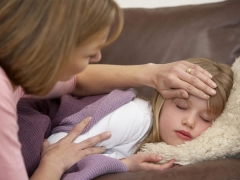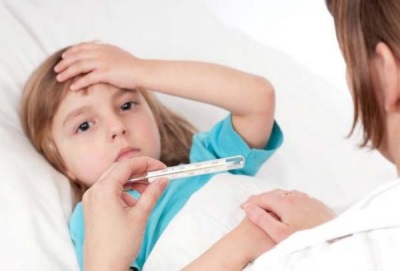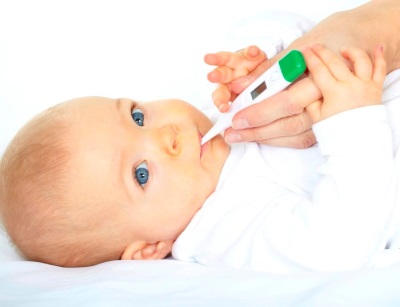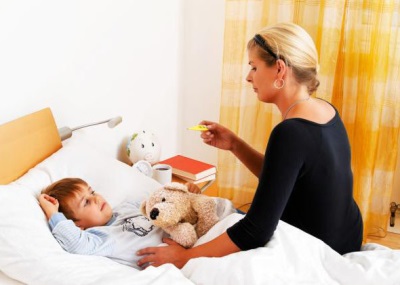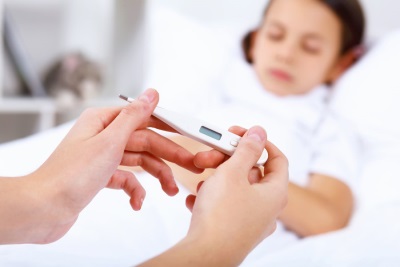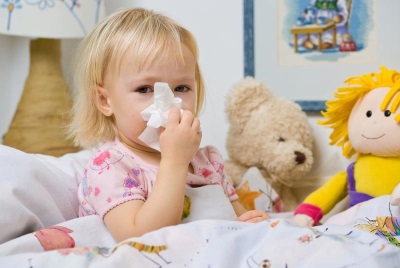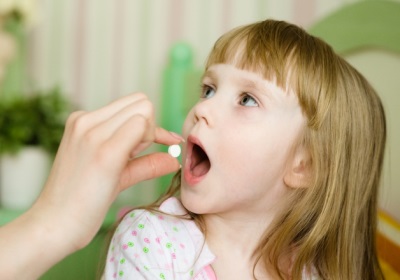High temperature in a child
Increased body temperature is possible with various diseases in childhood. At the same time, the question of whether to shoot her down causes a lot of controversial opinions.
Someone from the parents heard that during fever the body is more actively fighting the disease, and if the temperature is brought down, the duration of the disease will increase. Others have heard that both its elevated values and the drugs against it are very dangerous and threaten serious health problems.
As a result, some parents are afraid to bring down the temperature, even in cases where it is required, others give crumbs with a slight increase. Let's see what really needs to be done in these cases, as well as whether this symptom is a symptom of the disease.
How to measure the temperature?
The measurement in the armpits is the most accessible and simple, so it is most common.
However, there are other ways to measure:
- In the mouth (determined by oral temperature). To measure usually use a special thermometer in the form of a dummy.
- In the rectum (determine the rectal temperature). This method is used when the child is less than 5 months old, since children older than six months will resist the procedure. Thermometer (necessarily electronic) is processed by the cream and is inserted into the anus of the baby about two centimeters.
- In the inguinal crease. The baby is laid on its side, the tip of the thermometer is placed in the skin fold, and then the child’s foot is held in a position pressed to the body.
It is important that the child has a separate thermometer, and before use it should be treated with alcohol or washed with soapy water.
Also, when measuring you need to follow the following rules:
- For a sick child, measurements should be taken at least three times a day.
- Do not determine the temperature if the baby is very active, crying, taking a bath, warmly wrapped up, as well as in case of high temperature of the air in the room.
- If you determine the oral temperature, this should be done 1 hour before eating and drinking, or 1 hour after, as drinks and food increase the values in the oral cavity.
Normal values
Features of temperature in infants are inconsistency and rapid increase in any disease. In addition, in infants up to a year in the norm, it is slightly higher than in older children.
The normal temperature for a child under 12 months is less than + 37.4 ° C, and for a child over 12 months - less than + 37 ° C. These are measurements of temperature in the axillary region, as well as in the inguinal fold. For rectal measurements, the norm is considered to be less than + 38 ° C, and for oral, less than + 37.6 ° C.
The use of a mercury thermometer gives the most reliable indicators, while electronic thermometers have a significant error. To find out how different the electronic and mercury thermometer indicator is, measure the temperature at once by two thermometers from any healthy family member.
Classification
Depending on the indicators, the temperature is called:
- Subfebrile. Indicator - up to +38 degrees. Typically, this temperature is not knocked down, allowing the body to produce substances that protect it from viruses.
- Febrile Increase more than + 38 ° C, but less than + 39 ° C. Such a fever indicates that the child’s body is actively fighting the infection, so the parents ’tactics must take into account the child’s condition. If it is severely impaired, antipyretic drugs are indicated, and you can stop giving medication to a cheerful and calm child.
- Pyretic. Indicators on the thermometer from + 39 ° С to + 41 ° С. It is recommended to lower this temperature with medicines, as the risk of seizures increases.
- Hyperpyretic. The most dangerous is the temperature above + 41 ° С. Seeing this figure on the thermometer, you should immediately call an ambulance.
pros
- Allows you to quickly diagnose many diseases in the early period and begin timely treatment.
- With influenza virus, high temperature is important for high levels of interferon, which can successfully fight infection.
- At elevated body temperature, microorganisms cease to multiply and become less resistant to the effects of antibacterial agents.
- Fever activates the baby’s immune system, enhancing phagocytosis and the production of antibodies.
- A child with a fever is in bed, thanks to which his strength is completely directed at fighting the disease.
Minuses
- One of the complications is the appearance of seizures.
- During fever, the load on the baby’s heart rises, which is especially dangerous if the crumbs have rhythm disturbances or heart defects.
- When the temperature rises, the brain, as well as the liver, stomach, kidneys and other internal organs suffer.
Stages
To start the mechanism of raising the body temperature usually need foreign substances entering the body of the child - pyrogens. They can be various infectious agents represented by unicellular, viruses, protozoa, fungi, bacteria. When ingested, pathogens are absorbed by white blood cells (leukocytes). At the same time, these cells begin to produce interleukins that enter the brain with blood.
Reaching the center of the regulation of body temperature, located in the hypothalamus, these compounds change the perception of normal temperature. The brain of the baby begins to determine the temperature of 36.6-37 degrees as too low. He gives the command to the body to produce more heat and simultaneously spasm blood vessels to reduce heat transfer.
In this process, the following stages are distinguished:
- Heat is produced in the body of the baby in larger quantities, but the heat transfer is not increased. Body temperature rises.
- Heat transfer increases and a balance is established between heat generation and its excretion from the body. The temperature decreases, but not to normal values.
- Heat production is reduced due to the death of infectious agents and a decrease in the production of interleukins. The return of heat remains high, the child sweats, and the temperature returns to normal.
It should be noted that the temperature can decrease lytically (gradually) or critically (sharply). The second option is very dangerous expansion of blood vessels and lower blood pressure.
Is immunity really produced?
Numerous studies have confirmed that in some infections, fever contributes to faster recovery. It was also found that the use of antipyretic for some time prolongs both the time of the disease itself and the period of infectiousness. But, since these effects do not apply to all infections with high fever, it is impossible to speak about the unequivocal benefit of fever.
Scientific studies have shown that active compounds produced at high temperatures (interferon among them) in some cases help to recover faster, and in some diseases affect their course negatively. In addition, for many children, this is a very dangerous condition.
What happens if you do not churn the heat?
For a long time, high fever was considered a factor capable of disrupting blood clotting and causing overheating of the brain. Therefore, it was feared and tried to reduce in all sorts of ways. However, modern scientific research has shown that it is not the heat itself that leads to health problems, but the disease that is manifested by such a symptom.
At the same time, doctors note that fever is a danger to children with chronic pathologies of internal organs, symptoms of dehydration, impaired physical development or illness of the nervous system.
The danger of hyperthermia lies in the large expenditure of energy and nutrients to maintain a high temperature. Because of this, internal organs overheat and their function is impaired.
Maximum Valid Values
It is determined primarily by the age of the baby:
Age | The temperature at which you need to seek medical help |
From birth to 2 months | Above + 38 ° С |
3 to 24 months | More than +39 ° С |
2-3 years | More than + 39.5 ° С |
Above 3 years old | More than + 40 ° С |
If you see on the thermometer the numbers indicated above in the table, this indicates a high probability of a serious illness, therefore it is extremely important to immediately call a doctor for such temperature measurements.
When febrifuges are needed?
It is usually recommended to churn the febrile temperature if the child does not tolerate this condition, but there are situations where it is worth giving febrifuge and at subfebrile indicators:
- If the child is less than 2 months.
- When a baby has a disease of the cardiovascular system.
- In the past, the child had convulsions at high temperatures.
- If the child has a disease of the nervous system.
- When a child has hyperthermia caused by overheating.
Additional symptoms
High fever is rarely the only manifestation of a child’s health problems. Other signs of disease join it.
Red throat
Redness of the throat with fever is characteristic of viral and bacterial infections affecting the nasopharynx. Such symptoms often occur with angina, scarlet fever and other childhood infections. The child complains of pain when swallowing, begins to cough, refuses to eat.
Runny nose
The combination of fever and runny nose is most common in viral infections, when viruses infect the nasal mucosa. A child may also have symptoms such as weakness, refusal of food, difficulty breathing through the nose, lethargy, sore throat, cough.
Cold feet and hands
A condition where, at an elevated temperature in a child, pale skin and her blood vessels are spasmed is called white fever. To the touch the limbs of a baby with such a fever will be cold. The child usually has chills. This condition requires immediate medical attention. The body of the child should be rubbed with hands, but the use of wiping with water and other methods of physical cooling is prohibited. To remove the spasm of skin vessels, the doctor will recommend to take a spasmolytic, for example, No-silo.
Cramps
Increased body temperature can cause seizures. Because of their association with elevated temperature, such convulsions are called febrile. They are diagnosed in children younger than 6 years of age with rates above + 38 ° C, as well as in children with pathologies of the nervous system in any figures.
When febrile convulsions in a child, muscles begin to twitch, legs can be straightened and arms bend, the baby turns pale, does not respond to the surrounding environment, it is possible to hold the breath and blue skin. It is important to immediately lay the baby on a flat surface with his head turned on his side, call an ambulance and not leave the baby for a minute.
Vomiting and diarrhea
Such symptoms against the background of an elevated temperature usually indicate the development of an intestinal infection, but they can also be caused by the use of certain foods by a young child. In babies younger than 3 years, the intestines are not yet fully matured, so those foods that are normally tolerated by older children can cause dyspepsia and fever.
In addition, the combination of fever with vomit may signal not only the defeat of the digestive tract. Such symptoms are characteristic of meningitis and acetonemic syndrome. In children younger than 7 years old, vomiting can occur at elevated body temperatures and without damage to the brain or the digestive system. It happens at the peak of a temperature increase, usually once.
Abdominal pain
The emergence of complaints of pain in the abdomen in the background of fever should alert the parents and cause an ambulance call. So can serious illnesses that require surgery (for example, appendicitis), and kidney disease, and diseases of the digestive tract. To clarify the reasons, the child will be assigned tests and additional examinations.
No additional symptoms
The absence of other signs of the disease often occurs during dentition, as well as in situations where the disease is just beginning (other symptoms appear later). High fever, as the only symptom, is often noted in kidney infections. To confirm the disease can be urine tests and ultrasound study.
The reasons
The increased temperature is a protective reaction of the child’s body to the entry of pathogens into it, but it may also be due to non-infectious causes.
Diseases
A very common cause of fever are infectious diseases:
Disease | How does it appear besides high temperature? | What to do? |
ARVI | The appearance of a runny nose, dry cough, complaints of sore throat, body aches, muscle pain, nasal congestion, sneezing. | To call the pediatrician, to give a lot of drink, if necessary to give a febrifuge. |
Chickenpox or other childhood infection | Rash, sore throat, swollen lymph nodes in the neck. | It is imperative that you call a doctor so that he accurately diagnoses and recommends proper treatment. |
Otitis | The appearance of pain in the ear, as well as discharge from the ear, cough, runny nose. | Contact a pediatrician for an examination of the child and the appointment of an appropriate treatment situation. |
Infectious mononucleosis or tonsillitis | Severe sore throat, the appearance of plaque on the tonsils, an increase in lymph nodes in the neck. | Urgently call a doctor to clarify the diagnosis and start treatment immediately. |
Urinary tract infections | Pain in the lower back or abdomen, painful and frequent urination, changes in the smell and appearance of urine. | Contact a pediatrician to get tested, to identify the disease and begin treatment. |
Intestinal infections | Attacks of vomiting and nausea, spasmodic pain in the abdomen, disorder of the stool. | Give the child more drink, stop feeding, call the pediatrician. |
An increase in body temperature is also possible in cases of non-infectious diseases, for example, problems with hormones, pathologies of the nervous system and other health problems. It may also indicate acute surgical diseases that require immediate medical attention.
Teething
This reason is very common in younger children, but the indicators are usually up to + 38.5 ° C. In rare cases, the fever can be very strong, and the child refuses to eat and is sluggish.
Additional signs that indicate precisely the connection of teething and high temperature will be enhanced salivation, redness of the gums, restless naughty behavior of the baby. The child will chew on different objects and hands.
Overheat
In case of overheating, parents notice a connection between the increase in temperature and the effects of heat on the child, for example, a fever appeared after a long stay in the sun. In infants, overheating may result in the use of excessively warm clothing.Also, parents can themselves provoke overheating when a baby is wrapped up with a small increase.
The danger of overheating is associated with the risk of thermal shock. It is manifested not only by high fever, but also by impaired consciousness, convulsions, impaired heart function and breathing. Heat stroke is a reason to immediately call an ambulance.
Vaccinations
Preventive vaccination can cause a rise in temperature within a few days after the procedure. In this case, the child may experience swelling and pain at the site of the vaccine. These symptoms indicate the production of immunity and are considered acceptable side effects of vaccinations. In this case, antipyretic drugs can be given even with a slight increase in performance.
If after 1-2 days the temperature after vaccination does not decrease, it is necessary to determine whether its increase is caused by another reason, for example, a viral infection. Read more in the article about temperature increase after vaccination.
When to call a doctor?
The doctor should be called in each case of fever, as only a specialist will be able to determine what caused and how to treat the baby.

Indications for an immediate call to the doctor are such situations:
- The temperature has risen above the indicators considered maximum for a certain age of the child.
- Fever provoked seizures.
- The kid is disoriented, he has hallucinations.
- If there are other dangerous symptoms - vomiting, abdominal pain, difficulty breathing, earache, rash, diarrhea and others.
- A child's temperature is elevated for longer than 24 hours and during this time the condition has not improved.
- The baby has serious chronic diseases.
- You doubt that you are able to properly assess the condition of the baby and help him.
- The child went on the mend, but the temperature rose again.
- The baby refuses to drink and parents notice the symptoms of dehydration.
What to do?
Once the cause has been identified, it is necessary to determine how to deal with such a symptom. Taking into account the condition of the baby, his age, temperature figures and related facts, the parents and the doctor decide whether they need antipyretic drugs.
Antipyretics
In most cases, such drugs allow, albeit briefly, to improve the condition of the child, to allow him to sleep and eat. With angina, otitis, teething, stomatitis, these drugs reduce pain.
Will rubdowns help?
Used in the past, rubbing with vinegar, alcohol or vodka today are considered pediatricians harmful procedures. Doctors do not advise wiping the child even with a cool towel, because such actions provoke a spasm of blood vessels in the skin of the child, and this in turn will reduce the heat transfer. In addition, alcohol-containing liquids when rubbed will actively get into the body of the child, which is fraught with poisoning of the baby.
Rubdowns are permissible only after the use of drugs prescribed by a doctor, relieving the spasm of peripheral vessels. For the procedure using only water at room temperature. In addition, wiping the child can be provided that the baby does not mind, as with resistance and shouts, the temperature will increase even more. After wiping the child should not wrap, otherwise his condition will worsen.
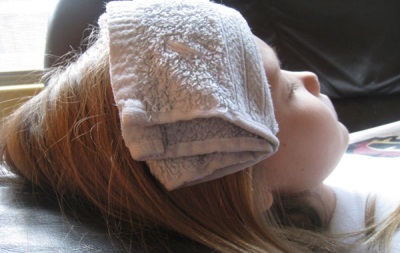
Food and liquid
Drinking a child with fever should often and a lot. Give your child tea, compote, water, juice or any other liquid that he agrees to drink. This is extremely important for heat transfer through greater evaporation of sweat from the skin, as well as for more rapid elimination of toxins in the urine.
Food should be given to the baby in small quantities. Let the child eat by appetite, but a little, because when digesting food, the body temperature will increase.And the dishes and drinks offered to the child, the temperature should be about 37-38 degrees.
Folk remedies
They recommend drinking tea with the addition of cranberries: it stimulates active sweating. At the same time, such a drink should be given carefully - in infants up to one year old, it can cause allergies, and older children should not use cranberries for any stomach ailments.
Another great folk remedy with antiseptic and antipyretic effect is raspberry, which can be given to a child in the form of jam, juice or tea. But in cases where there is a risk of allergies, the use of raspberries is best avoided.
How safe is the treatment?
The use of modern drugs that reduce the temperature is considered safe if the following conditions are observed:
- Do not give to children under 18 aspirin and other products that have acetylsalicylic acid.
- Do not exceed the dosage recommended in the instructions.
- Do not take medications if they are contraindicated.
- Do not reduce the antipyretic increased the temperaturewhich is a symptom of chickenpox (this increases the risk of complications).
How many days does the child have high fever?
For a baby, not the fever itself is dangerous, but the cause of the appearance of this symptom. If the parents do not know what caused the baby to rise in temperature and the state did not improve the next day after the increase in indicators, as well as additional warning symptoms appeared, you should immediately seek medical help. So you determine the cause of the child’s illness and can affect it, and not just the symptom.
If the cause of hyperthermia is known to the parents, and it does not constitute a danger, the doctor examined the child and prescribed therapy, then the temperature can be reduced for a few (3-5) days while observing the child. If there are no positive changes in the course of the disease over the past three days, despite the treatment, you should call the doctor again and undergo an additional examination.
rules
- Selecting a specific drug to reduce the temperature, determine the desired single dose according to the instructions.
- It is necessary to accept febrifuge only if necessary.
- A minimum of 4 hours should be elapsed before the next dose for paracetamol or 6 hours for ibuprofen.
- During the day, you can take a maximum of 4 doses of the drug.
- The medication, taken by mouth, washed down with water or milk. It can also be drunk during the meal - so the irritating effect of drugs on the gastric mucosa will be reduced.
What medicines to choose?
Drugs that are recommended in children at high temperatures are paracetamol as well as ibuprofen. Both remedies reduce pain equally, but ibuprofen has a more pronounced and prolonged antipyretic effect. In this case, paracetamol is called safer and is recommended as a drug of choice for babies in the first months of their lives.
Breast babies are often given such drugs in the form of rectal suppositories or syrups. This is due to the ease of use of these forms - they are easy to dose and give the child. In older children, preference should be given to tablets, syrups and soluble powders.
The action taken through the mouth of drugs begins within 20-30 minutes after their use, and rectal suppositories - 30-40 minutes after administration. Candles will also be the most preferred option in the presence of bouts of vomiting in a child. In addition, syrups, powders and tablets often include additives for taste and smell, which can cause allergies.
You can hear the recommendations to take paracetamol and ibuprofen together or with alternating these drugs. Doctors believe that it is safe, but not a necessity. The combination of these drugs works with the same efficiency as taking ibuprofen alone.And if you have given this medicine, and the temperature does not decrease, do not give paracetamol in addition, it is better to call an ambulance right away.
Why shouldn't aspirin be given to children?
Even as an adult, it is advised to avoid using aspirin at a temperature where possible, and it is completely contraindicated in children under 18 years of age.
In childhood, aspirin has a pronounced toxic effect on the liver and is the cause of the development of serious complications, which doctors call “Ray's syndrome”. This syndrome affects the internal organs, in particular the liver and brain. Also taking aspirin can affect platelets, cause bleeding and allergies.
If there are no other antipyretic drugs in the house, aspirin should not be given to the child anyway. If you have purchased any new medicine recommended for colds or flu, be sure to check if it contains acetylsalicylic acid.
Tips
- In the room, reduce the temperature of the air to 18-20 degrees to increase heat transfer (if the baby does not have chills). You should also take care of sufficient moisture (the optimal level is 60%), since the dryness of the air will contribute to the loss of children's body fluids and drying out mucous membranes.
- Choosing clothes for the child, make sure that the baby is not cold, but you shouldn’t overheat the crumbs with too warm clothes. Dress the child in the same way as you are dressed or a little lighter, and when the baby starts to sweat and wants to undress, allow him to release more heat in this way.
- Limit the activity of the child, because some kids even at temperatures above 39 degrees run and jump. As movement increases heat production in the body, distract the child from active games. However, make it so that the baby does not cry, because hysterical and crying she will also rise. Offer your child reading books, watching cartoons, or some other quiet activity. To force the child to lie down constantly is not necessary.
